2. 非常规油气成藏与开发省部共建国家重点实验室培育基地, 大庆 163318
2. Accumulation and Development of Unconventional Oil and Gas, State Key Laboratory Cultivation Base Jointly-constructed by Heilongjiang Province and the Ministry of Science and Technology, Heilongjiang Daqing 163318, China
随着勘探开发的深入, 低孔低渗储层、低阻油层、致密储层等复杂泥质砂岩储层已成为油田增储上产的一个重要来源, 但由于该类储层的导电规律主要受其复杂孔隙结构以及泥质含量和泥质分布形式的影响, 对于含钙储层, 还受钙质胶结的影响, 因此, 致使复杂泥质砂岩储层导电规律与常规储层导电规律有很大差别, 多表现为非阿尔奇关系.而目前用于评价复杂泥质砂岩储层饱和度的导电模型主要有改进阿尔奇方程(李秋实等, 2002; 李潮流等, 2010; 张丽华等, 2010; 郑雷清等, 2010; 宋延杰等, 2012; 王长江等, 2013)、泥质电阻率模型和双电层导电模型(宋延杰等, 1995; 李辉等, 2006; 杨雪, 2007; 程相志等, 2008; 陈继华等, 2011)、三孔隙导电模型(莫修文等, 2001; 张奉东, 2009; 张丽华等, 2010; 张丽华等, 2011; 石玉江等, 2012).虽然这些导电模型在复杂泥质砂岩储层饱和度评价中取得了较好的应用效果, 但是它们均基于并联导电理论和阿尔奇公式在一定假设基础上建立的, 这在一定程度上限制了该类模型扩展描述孔隙结构更复杂的高泥高钙砂岩储层的导电规律, 因此, 促使人们去研究更一般的新导电理论.有效介质对称各向异性导电理论(De Kuijper, 1996; Koelman, 1997)用于描述N种组份的各向异性、渗滤的混合介质电导率, 它将N种组份均处理为对称的, 且允许N种组份均可作为连续项存在.通过引入渗滤指数和渗滤速率几何参数来描述各种组份的连通性、表面的粗糙度、形状、润湿性等, 并结合各种组分含量, 建立了虚介质电导率的参数化方法.将有效介质对称各向异性导电理论应用于由不导电骨架颗粒和油气、粘土颗粒、水三种组份组成的泥质砂岩地层, 建立了基于对称各向异性理论的电阻率模型(SATORI), 并利用泥质砂岩岩电实验数据, 证明了该电阻率模型能很好地描述泥质砂岩岩电规律.有效介质对称各向异性导电理论突出优点是它可描述复杂地层的导电规律, 并允许地层中多个组份以连续项形式存在.自该理论提出后, 宋延杰等开始研究将该理论用于描述复杂泥质砂岩地层导电规律, 并确定其饱和度.2004年和2005年, 宋延杰等将有效介质对称导电理论用于描述由导电骨架颗粒、不导电油气、粘土颗粒、水4种成份组成的分散泥质砂岩导电规律而用并联导电理论描述层状泥质与分散泥质砂岩之间的导电规律, 建立考虑泥质分布形式影响的泥质砂岩有效介质通用对称电阻率模型, 实验验证与实际应用表明该模型能很好地描述混合泥质砂岩的导电规律.2008年, 宋延杰、唐晓敏将有效介质对称导电理论用于描述由分散泥质、层状泥质、骨架含导电矿物、微孔隙发育、高矿化度地层水等5种成因类型引起的低阻油层导电规律, 建立了适用于5种成因的低阻油层通用电阻率模型, 并取得了较好的应用效果.2008年和2011年, 杨景强和宋延杰、陈东霞等人将有效介质对称导电理论用于描述钙质对岩石导电性的影响.2010年, 宋延杰等将有效介质对称导电理论用于描述泥质含量高、微孔隙发育、孔隙结构复杂、束缚水饱和度高的低孔低渗储层导电规律, 建立了低孔渗储层电阻率模型, 并取得了较好的应用效果.2011年和2014年, 宋延杰等将有效介质对称导电理论用于描述孔隙结构复杂、孔渗非常低的致密砂砾岩储层导电规律, 建立了致密砂砾岩电阻率模型, 并取得了较好的应用效果.2014年, 宋延杰等利用有效介质对称导电理论描述泥质对岩石导电性的影响, 利用等效岩石元素理论描述孔隙结构对岩石导电性的影响, 将这两种理论结合, 建立了含泥特低渗透储层饱和度模型, 并取得了较好的应用效果.
总之, 有效介质对称导电理论能很好地描述复杂泥质砂岩储层导电规律, 用该理论建立的导电模型提高了复杂泥质砂岩储层饱和度评价精度, 具有很好的应用前景.但对有效介质对称导电理论是否能描述纯砂岩非阿尔奇规律, 与阿尔奇相比具有哪些优点; 能否描述泥质附加导电规律, 与泥质电阻率模型或双电层导电模型相比具有哪些优点; 能否描述并联或串联导电规律等问题, 仍需深入研究, 以更好地指导该理论在复杂储层中正确应用.
1 有效介质对称导电理论有效介质对称导电理论是用来描述多组分组成的混合介质电导率(Koelman, 1997; De Kuijper, 1996), 其形式为

|
(1) |
式中, Ck为混合介质中第k种成分电导率, S/m; φk为混合介质中第k种成分体积分数, 小数; C0g为虚介质的电导率, S/m; Cmix为混合介质的电导率, S/m; N为混合介质的组分数.
虚介质电导率表达式为

|
(2) |
其中, 渗滤速率λk反应岩石中第k种成分的连通状况, 渗滤指数γk反应岩石中第k种成分的形状和结构.
2 纯砂岩有效介质对称导电理论应用基础研究 2.1 含水纯砂岩有效介质对称导电模型对于骨架不导电的含水纯砂岩地层, 根据有效介质导电方程(1) 式和(2) 式, 可得:

|
(3) |

|
(4) |
式中, λma、λw分别为纯砂岩中的骨架颗粒和水的渗滤速率, 无量纲; γ1为纯砂岩中的骨架颗粒渗滤指数, 无量纲; Co、Cw分别为含水纯砂岩和水的电导率, S/m; φ为纯砂岩的有效孔隙度, 小数.
将(4) 式代入(3) 式, 整理得:

|
(5) |
由(5) 式, 根据地层因素的定义, 可得地层因素为

|
(6) |
对于骨架不导电的含油气纯砂岩地层, 根据有效介质导电方程(1) 式和(2) 式, 并假设λma=λh, 可得:

|
(7) |

|
(8) |
式中, Ct为含油气纯砂岩电导率, S/m.
将(8) 式代入(7) 式, 整理得:

|
(9) |
由(9) 式和(5) 式, 根据电阻增大系数的定义, 可得含油气纯砂岩电阻增大系数为

|
(10) |
其中, φh=φ-φw, φw=φSw. 式中, Sw为含水饱和度, 小数.
2.3 纯砂岩有效介质对称导电模型理论研究 2.3.1 物理约束(1) 当孔隙度很大时, 岩石颗粒断续地分散在水中, 有λma=0.将λma=0代入(6) 式, 整理得:

|
(11) |
(11) 式与Maxwell方程用于分散水中相同尺寸的球形颗粒的推导结果相符.
(2) 当孔隙度很小时, 水在岩石孔隙中呈断续分布, 有λw=0.将λw=0代入(6) 式, 整理得:

|
(12) |
由(12) 式可知, 当λw=0时, F为无穷大; 与水在岩石孔隙中呈断续分布时Co趋于零, F为无限大相符.
(3) 当φ=1.0时, 由(6) 式可知, 无论λma、λw和γ1为何值, 有效介质对称导电理论推导出F=1.0; 与按照F定义在φ=1.0情况下F=1.0相符.
(4) 当Sw=1.0时, φw=φ, 由(10) 式可知, 无论λma、λw和γ1为何值, 有效介质对称导电理论推导出I=1.0; 与按照I定义在Sw=1.0情况下I=1.0相符.
2.3.2 理论分析利用(6) 式和(10) 式分别研究在λma=1.0条件下, λw和γ1变化纯砂岩有效介质对称导电模型预测的F和φ、I和Sw关系的变化.
图 1和图 2分别给出了不同λw和γ1的F与φ以及I与Sw交会图, 从图中看出纯砂岩有效介质对称导电模型预测的地层因素与孔隙度, 以及电阻增大系数与含水饱和度的理论关系, 既可以描述纯砂岩阿尔奇规律, 也可以描述纯砂岩非阿尔奇规律.
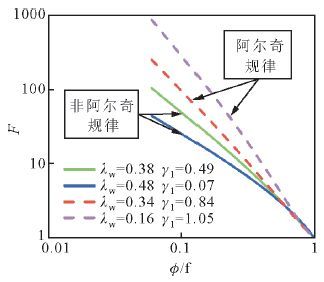
|
图 1 纯砂岩有效介质对称导电模型预测F 与φ 理论关系 Figure 1 Theoretical relation of formation factor and porosity predicted from symmetrical effective medium conduction model for clean sands |
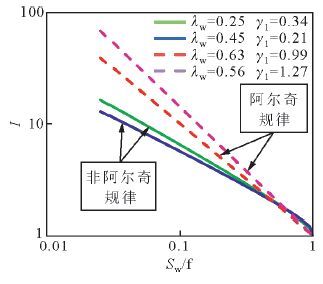
|
图 2 纯砂岩有效介质对称导电模型预测I与Sw 理论关系 Figure 2 Theoretical relation of resistivity index and water saturation predicted from symmetrical effective medium conduction model for clean sands |
为了检验纯砂岩有效介质对称导电模型对低孔渗砂岩储层非阿尔奇规律的描述情况, 引用塔里木盆地TZ4井石炭系巨厚砂岩储层和我国东部H盆地三个砂岩储层岩心样品地层因素与孔隙度实验数据(毛志强等, 1997), 以及北海砂岩储层岩心样品电阻增大系数与含水饱和度实验数据(Shang等, 2008), 根据(6) 式和(10) 式, 利用最优化技术求解F-φ和I-Sw的非相关函数, 可优化得到模型中各未知参数值.将优化的各参数值分别代入(6) 式和(10) 式, 计算每块岩样对应不同孔隙度的地层因素值和对应不同含水饱和度的电阻增大系数值.图 3和图 4给出了有效介质对称导电模型计算岩样地层因素与测量岩样地层因素对比图, 图 5给出了有效介质对称导电模型计算岩样电阻增大系数与测量岩样电阻增大系数对比图(其中符号点为岩心测量数据, 曲线为方程计算结果).从图中可以看到曲线与符号点的吻合很好, 说明有效介质对称导电模型能够较好地描述纯砂岩的非阿尔奇规律.
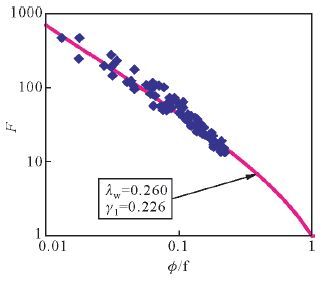
|
图 3 塔里木盆地砂岩岩样计算地层因素与测量地层因素对比 Figure 3 Comparison of measured formation factor with calculated formation factor from symmetrical effective medium conduction model for sand samples from Tarim basin |
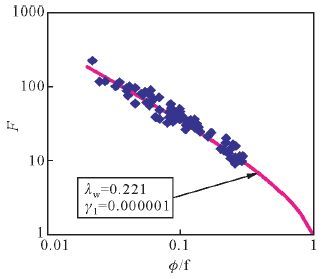
|
图 4 H盆地砂岩岩样计算地层因素与测量地层因素对比 Figure 4 Comparison of calculated formation factor with measured formation factor from symmetrical effective medium conduction model for sand samples from H basin |

|
图 5 北海砂岩岩样计算电阻增大系数与测量电阻增大系数对比 Figure 5 Comparison of measured resistivity index with calculated resistivity index from symmetrical effective medium conduction model for sand samples from North Sea |
对于由不导电骨架颗粒、不导电油珠、分散粘土颗粒、水四种成份组成的分散泥质砂岩地层(宋延杰, 2006), 根据有效介质导电方程(1) 式和(2) 式, 并假设分散粘土颗粒是不连续的, 即λcl=0以及λma=λh, 可得:

|
(13) |
式中, Vcl、Ccl分别为分散粘土含量和电导率, 小数和S/m.

|
(14) |
对于含水分散泥质砂岩地层, 有φw=φ, φh=0.将这些值代入(13) 式和(14) 式, 得:

|
(15) |
由(15) 式知, 对于含水分散泥质地层, Co与Cw为曲线关系.当Cw很大时, Co与Cw的关系近似为直线关系.图 6给出了当Ccl=0.5(S/m), 总孔隙度φt=0.25, 粘土孔隙度φtcl=0.2, φ=φt-Vclφtcl, γ=1.135, λma=1.0, λw=0.4时, 泥质砂岩有效介质对称导电模型预测的含水分散泥质砂岩的Co与Cw关系, 该图说明泥质砂岩有效介质对称导电模型完全可以描述分散泥质砂岩的Co与Cw关系, 即对于分散泥质砂岩, 在低地层水电导率的范围内, Co与Cw为曲线关系, 而当地层水电导率大于某一值后, Co与Cw为线性关系.

|
图 6 泥质砂岩有效介质对称导电模型预测的含水分散泥质砂岩的Co与Cw关系 Figure 6 Water-saturated shaly sand conductivity versus water conductivity predicted from symmetrical effective medium conduction model for shaly sands |
假设Ccl=0.5(S/m), Cw=0.83(S/m), γ=1.0, λma=1.0, λw=0.4, φt=0.25, φtcl=0.2, 图 7和图 8分别给出了泥质砂岩有效介质对称导电模型预测的不同分散粘土含量和粘土电导率的Rt与Sw交会图.从图中可以看出, 随粘土含量增大, 粘土电导率增大, 岩石电阻率减小, 该结果与粘土对岩石导电规律的影响理论认识相符.

|
图 7 泥质砂岩有效介质对称导电模型预测的不同分散粘土含量的Rt与Sw交会图 Figure 7 Plot of resistivity index and water saturation for different clay content predicted from symmetrical effective medium conduction model for shaly sands |

|
图 8 泥质砂岩有效介质对称导电模型预测的不同粘土电导率的Rt与Sw交会图 Figure 8 Plot of resistivity index and water saturation for different clay conductivity predicted from symmetrical effective medium conduction model for shaly sands |
利用泥质砂岩有效介质对称导电模型, 对12块泥质砂岩岩样实验测量数据(Waxman和Thomas, 1974; Clavier和Coates等, 1984)进行优化拟合可得到Vcl、Ccl和γ、λw值, 再将优化参数值代入有效介质对称导电模型中, 计算出每块岩样不同含水饱和度的岩石电导率值, 从而得到计算岩样电导率与测量岩样电导率的平均相对误差, 见表 1.从表中可知, 计算的岩样电导率平均相对误差最小为1.2%, 最大为3.4%.图 9、图 10分别给出了电导率平均相对误差最大的两块岩样的模型计算电导率与岩心测量电导率对比图(符号点代表岩心测量数据, 曲线代表模型拟合结果), 从图中看出模型计算电阻率与岩心测量电阻率吻合很好.12块岩样的计算电导率与测量电导率的平均相对误差为2.3%, 误差很小, 说明有效介质对称导电模型能很好地描述分散泥质砂岩岩电实验规律.

|
图 9 3218C号岩心样品的计算电阻率与测量电阻率对比 Figure 9 Comparison of measured resistivity with calculated resistivity from symmetrical effective medium conduction model for sample 3218C |

|
图 10 3279B号岩心样品的计算电阻率与测量电阻率对比 Figure 10 Comparison of measured resistivity with calculated resistivity from symmetrical effective medium conduction model for sample 3279B |
|
|
表 1 泥质砂岩有效介质对称电阻率模型计算分散泥质砂岩岩样电导率与测量电导率对比 Table 1 Comparison of measured conductivity with calculated conductivity from the proposed conduction model for dispersed shaly sand samples |
对于层状泥质和纯砂岩或分散泥质砂岩组成的岩石, 当电场方向平行于层状泥质延伸方向时, 两种成份组成的混合介质导电规律遵循并联导电, 而当电场方向垂直于层状泥质延伸方向时, 两种成份组成的混合介质导电规律遵循串联导电.对于这两种情况, 利用有效介质对称导电理论描述两种成份组成的混合介质导电规律是否合适, 需要深入研究.
4.1 两组份混合介质有效介质对称导电方程对于两种成份组成的混合介质, 根据有效介质导电方程(1) 式和(2) 式, 可得:

|
(16) |
式中, C1、C2分别为两种介质的电导率, S/m; V1、V2分别为两种介质的相对含量, 小数; λ1、λ2分别为两种介质的渗滤速率, 无量纲; γ1、γ2分别为两种介质的渗滤指数, 无量纲.
4.2 两组分混合介质并联和串联导电方程对于两种成份组成的混合介质, 按照并联导电理论, 有:

|
(17) |
对于两种成份组成的混合介质, 按照串联导电理论, 有:

|
(18) |
给定两组不同C1和C2值, 由(17) 式和(18) 式分别得到2组Ct-V2理论关系数据.对于每组组数据, 利用最优化技术对方程(16) 求解Ct-V2的非相干函数, 可得出方程(16) 中的参数值, 再将参数值代入方程(16) 中, 可得出有效介质对称导电方程对每组数据拟合的Ct-V2关系曲线.图 11和图 12给出了有效介质对称导电方程拟合的Ct-V2关系曲线与并联导电方程和串联导电方程计算的Ct-V2关系曲线比较, 从图中可以看出, 随两种介质电导率差别增大, 有效介质对称导电方程拟合的Ct-V2关系曲线与并联导电方程和串联导电方程计算的Ct-V2关系曲线的差别增大, 即有效介质对称导电理论不能描述并联导电理论和和串联导电理论所预测的两组分混合介质导电规律.
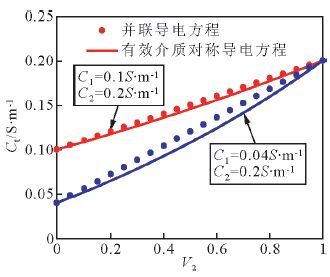
|
图 11 有效介质对称导电方程拟合的Ct-V2关系曲线与并联导电方程计算的Ct-V2关系曲线比较 Figure 11 Comparison of Ct versus V2 fitted from symmetrical effective medium conduction equation with Ct versus V2 calculated from parallel conduction equation for a two-component mixture |
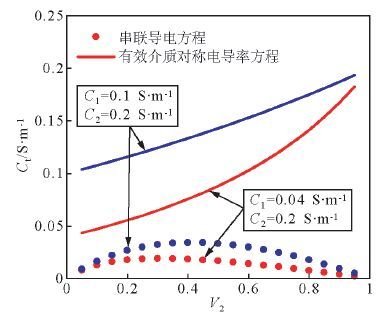
|
图 12 有效介质对称导电方程拟合的Ct-V2关系曲线与串联导电方程计算的Ct-V2关系曲线比较 Figure 12 Comparison of Ct versus V2 fitted from symmetrical effective medium conduction equation with Ct versus V2 calculated from series conduction equation for a two-component mixture |
5.1 有效介质对称导电理论可用于描述纯砂岩导电规律, 建立的纯砂岩有效介质对称导电模型优于阿尔奇方程, 不但可以描述纯砂岩阿尔奇规律, 而且可以描述纯砂岩非阿尔奇规律, 并且满足当孔隙度等于1时地层因素等于1, 以及当含水饱和度等于1时电阻增大系数等于1的物理约束.
5.2 有效介质对称导电理论可用于描述泥质砂岩导电规律, 建立的泥质砂岩有效介质对称导电模型优于泥质电阻率模型和双电层模型, 不需要采用经验拟合即可以描述饱含水分散泥质砂岩的电导率与地层水电导率之间曲线和直线关系.
5.3 有效介质对称导电理论与并联导电理论不等价, 也与串联导电理论不等价, 有效介质对称导电理论不能替代并联导电理论或串联导电理论, 即当两种组分混合介质遵循并联或串联导电规律时, 混合介质的导电规律不能用有效介质对称导电理论描述.
5.4 有效介质对称导电理论是一种全新的导电理论, 该理论将岩石中N种组份均处理为对称的, 且允许两种以上组份作为连续项存在, 符合实际地层情况, 在地层中, 除了骨架和水为连续项外, 当粘土含量较高时, 粘土包裹在骨架颗粒周围, 也可成为连续项.它通过引入渗滤指数和渗滤速率几何参数来描述各种组份的连通性、表面的粗糙度、形状、润湿性等对岩石导电性的影响, 因此, 有效介质对称导电理论的适用性广, 可用于描述复杂泥质砂岩的导电规律.
致谢 感谢审稿专家对本文提出的修改意见和编辑部的大力支持!.| [1] | Chen D X.2011.On interpretation method of complex oil zone and water zone in southern Gulong area[D].Daqing: College of Earth Science, Northeast Petroleum University. |
| [2] | Chen J H, Chen Z, Mao Z Q.2006. Analysis on the forming of low-resistivity oil layer and evaluation of the water saturation in Moxizhuang area[J]. Geophysical Prospecting for Petroleum (in Chinese), 50 (3) : 247–251. |
| [3] | Cheng X Z, Fan Y R, Zhou C C.2008. Identification technology of low resistivity pays in fresh water reservoir[J]. Earth Science Frontiers (in Chinese), 15 (1) : 146–153. |
| [4] | Clavier C, Coates G and Dumanoir J. 1984. The theoretical and experimental bases for the dual-water model for interpretation of shaly sands[J]. SPE Journal, 1984, April: 153-168. |
| [5] | De Kuijper A, Sandor R K J, Hofman J P, et al.1996. Electrical conductivities in oil-bearing shaly sand accurately described with the SATORI saturation model[J]. The Log Analyst : 22–31. |
| [6] | Koelman J M V A, De Kuijper A.1997. An effective medium model for the electric conductivity of an N-component anisotropic percolating mixture[J]. PHYSICA A, 247 : 10–22. DOI:10.1016/S0378-4371(97)00385-3 |
| [7] | Li H, Li W Z, Zhang J L, et al.2006. The mechanism and identification method of low resistivity reservoir in Zhengliuzhuang oilfield[J]. Well Logging Technology (in Chinese), 30 (1) : 76–79. |
| [8] | Li Q S, Zhou R A, Zhang J G, et al.2002. Relations between Archie's formula and reservoir pore structure[J]. Oil Gas & Geology (in Chinese), 23 (4) : 364–367. |
| [9] | Li S L, Li C X.2010. Electrical property analysis on especially low-permeability clastic reservoir[J]. Well Logging Technology (in Chinese), 34 (3) : 233–237. |
| [10] | Mao Z Q, Tan T D, Lin C Z, et al.1997. The laboratory studies on pore structure and electrical properties of core samples fully-saturated with brine water[J]. Acta Petrolei Sinica, 18 (3) : 53–57. |
| [11] | Mo X W, He D H, LI Z B, et al.2001. The application of three-water conduction model in the interpretation of low- resistivity reservoir[J]. Journal of Changchun University of Science and Technology (in Chinese), 31 (1) : 92–94. |
| [12] | Shang B Z, Hamman J G, Caldwell D H.2008.Improved water saturation estimation using equivalent rock element model and application to different rock types[C].//SPE Europec/EAGE Annual Conference and Exhibition. Rome, Italy: SPE, 1-9. |
| [13] | Shi Y J, Shi Z, Zhang H T, et al.2012. Fine logging interpretation method of tight gas reservoir in Sulige gas field[J]. Journal of Southwest Petroleum University (Science & Technology Edition) (in Chinese), 34 (5) : 71–77. |
| [14] | Song Y J. Comprehensive research on generalized resistivity models in laminated and dispersed shaly sands[D]. Daqing: Daqing Petroleum Institute, 2006. |
| [15] | Song Y J, Han J Q, Wang Y, et al.2010. On conductivity model with continuous clay distribution in low porosity and low permeability shaly sand reservoirs[J]. Well Logging Technology (in Chinese), 34 (3) : 205–209. |
| [16] | Song Y J, Tang X M.2008. Generalized effective medium resistivity model for low resistivity reservoir[J]. Science in China (Series D: Earth Sciences), 51 (8) : 1194–1208. DOI:10.1007/s11430-008-0077-5 |
| [17] | Song Y J, Wang H Q, Tang X M, et al.2010. Logging evaluation of low porosity and permeability reservoirs in the east of South Sea of China[J]. Journal of Daqing Petroleum Institute (in Chinese), 34 (6) : 106–110. |
| [18] | Song Y J, Wang N, Tang X M.2012. Application of tortuosity resistivity model in low permeability reservoirs in G area of Daqing oilfield[J]. Progress in Geophysics (in Chinese), 27 (5) : 2008–2015. DOI:10.6038/j.issn.1004-2903.2012.05.023 |
| [19] | Song Y J, Wang Q, Tian J X.1995. Method for distinguishing oil, gas and water bearing zones in low porous and permeable reservoir[J]. Journal of Daqing Petroleum Institute (in Chinese), 19 (2) : 35–38. |
| [20] | Song Y J, Wang X M, Lu S F.2005. A generalized equivalent resistivity model in laminated and dispersed shaly sands[J]. Exploration Geophysics, 36 (2) : 259–265. DOI:10.1071/EG05259 |
| [21] | Song Y J, Wang X M, Lu S F.2004.A generalized SATORI resistivity model of the effective media for laminated and dispersed shaly sand formation[C]. //The 7th Society of Exploration Geophysicists of Japan International Symposium, Sendai, Japan: SEGJ, 245-250. |
| [22] | Song Y J, Yang Z, Liu X Z, et al.2014. A saturation model for ultra-low permeability reservoirs based on the effective medium conduction theory and equivalent rock element theory[J]. Well Logging Technology (in Chinese), 38 (5) : 510–516. |
| [23] | Song Y J, Zhang X, Song Y, et al.2014. On effective medium conductivity model based on non-efficient electrical pore for tight sandy conglomerate reservoirs[J]. Progress in Geophysics (in Chinese), 29 (1) : 0209–0216. DOI:10.6038/pg20140129 |
| [24] | Song Y J, Zhu Y F, Li Q F , et al.2011. Comparison of gas saturation models for deep extra-low porous permeable sand reservoir in Xujiaweizi area[J]. Science Technology and Engineering (in Chinese), 11 (9) : 1912–1916. |
| [25] | Tang X M, Song Y J, Zhang C Y.2008. Application of generalized symmetrical effective medium resistivity model in low resistivity reservoirs[J]. Journal of Daqing Petroleum Institute (in Chinese), 32 (2) : 18–22. |
| [26] | Wang C J, Zhang Q, Chen Y S, et al.2013. Research on saturation model of tight-sandstone reservoir[J]. Qinghai Petroleum (in Chinese), 31 (2) : 22–26. |
| [27] | Waxman M H, Thomas E C.1974. Electrical conductivities in shaly sands- I. The relation between hydrocarbon saturation and resistivity index; II. The temperature coefficient of electrical conductivity[J]. JPT, 26 (2) : 213–225. DOI:10.2118/4094-PA |
| [28] | Yang J Q, Fan T L, Ma H Y, et al. 2008. Application of improved effective medium resistivity model in shale and calcite sands. Well Logging Technology (in Chinese), 32(6): 514-518. |
| [29] | Yang X.2007.Determination of water saturation model on low porosity and low permeability reservoir and its application in SongNan area[D].Changchun: College of Geo-Exploration Science and Technology, Jilin University. |
| [30] | Zhang F D, Pan B Z.2009. Application of three water model in reservoir fog interpretation in Yaoyingtai oilfield[J]. Global Geology (in Chinese), 28 (2) : 226–232. |
| [31] | Zhang L H, Pan B Z, Li N, et al.2011. Reservoir classification method based on three water model to evaluate low porosity and low permeability reservoir[J]. Well Logging Technology (in Chinese), 35 (1) : 31–35. |
| [32] | Zhang L H, Pan B Z, Li Z B, et al.2010. New three-water conduction model and its application in evaluation of low porosity and low permeability reservoir[J]. Oil Geophysical Prospecting (in Chinese), 45 (3) : 431–435. |
| [33] | Zhang L H, Pan B Z, Shan G Y.2010. Progress in study on methods of determining porosity exponent m[J]. Progress in Geophysics (n Chinese), 25 (3) : 975–981. DOI:10.3969/j.issn.1004-2903.2010.03.036 |
| [34] | Zheng L Q, Wang H, Pan H F, et al.2010. Saturation interpretation of tight-sandstone reservoir in Kekeya area[J]. Tuha Oil&Gas (in Chinese), 15 (2) : 241–244. |
| [35] | 陈东霞.2011.古龙南地区复杂油水层测井识别方法研究[D].大庆: 东北石油大学地球科学学院. |
| [36] | 陈继华, 陈政, 毛志强.2006. 莫西庄地区低阻油层成因分析与饱和度评价[J]. 石油物探, 50 (3) : 247–251. |
| [37] | 程相志, 范宜仁, 周灿灿.2008. 淡水储层中低阻油气层识别技术[J]. 地学前缘, 15 (1) : 146–153. |
| [38] | 李辉, 李伟忠, 张建林, 等.2006. 正理庄油田低电阻率油层机理及识别方法研究[J]. 测井技术, 30 (1) : 76–79. |
| [39] | 李秋实, 周荣安, 张金功, 等.2002. 阿尔奇公式与储层孔隙结构的关系[J]. 石油与天然气地质, 23 (4) : 364–367. |
| [40] | 李潮流, 李长喜.2010. 特低渗透率砂岩储集层电学性质研究[J]. 测井技术, 34 (3) : 233–237. |
| [41] | 毛志强, 谭廷栋, 林纯增, 等.1997. 完全含水多孔岩石电学性质及其孔隙结构实验研究[J]. 石油学报, 18 (3) : 53–57. |
| [42] | 莫修文, 贺铎华, 李舟波, 等.2001. 三水导电模型及其在低阻储层解释中的应用[J]. 长春科技大学学报, 31 (1) : 92–94. |
| [43] | 石玉江, 时卓, 张海涛, 等.2012. 苏里格气田致密气层测井精细建模方法[J]. 西南石油大学学报(自然科学版), 34 (5) : 71–77. |
| [44] | 宋延杰.混合泥质砂岩通用电阻率模型综合研究[D].大庆: 大庆石油学院, 2006. |
| [45] | 宋延杰, 韩建强, 王瑛, 等.2010. 考虑黏土连续性影响的低孔隙度低渗透率砂岩储层导电模型研究[J]. 测井技术, 34 (3) : 205–209. |
| [46] | 宋延杰, 唐晓敏.2008. 低阻油层通用有效介质电阻率模型[J]. 中国科学D辑, 38 (7) : 896–909. |
| [47] | 宋延杰, 王海琦, 唐晓敏, 等.2010. 南海东部低孔低渗储层测井评价方法[J]. 大庆石油学院学报, 34 (6) : 106–110. |
| [48] | 宋延杰, 王楠, 唐晓敏.2012. 曲折度电阻率模型在大庆G地区低渗储层评价中的应用[J]. 地球物理学进展, 27 (5) : 2008–2015. DOI:10.6038/j.issn.1004-2903.2012.05.023 |
| [49] | 宋延杰, 王群, 田家祥.1995. 低孔渗储层的油气水解释方法[J]. 大庆石油学院学报, 19 (2) : 35–38. |
| [50] | 宋延杰, 杨汁, 刘兴周, 等.2014. 基于有效介质与等效岩石元素理论的特低渗透率储层饱和度模型[J]. 测井技术, 38 (5) : 510–516. |
| [51] | 宋延杰, 张啸, 宋杨, 等.2014. 基于无效导电孔隙概念的致密砂砾岩有效介质导电模型[J]. 地球物理学进展, 29 (1) : 0209–0216. DOI:10.6038/pg20140129 |
| [52] | 宋延杰, 朱云峰, 李庆峰, 等.2011. 徐家围子地区深层特低孔渗砂岩储层含气饱和度模型对比[J]. 科学技术与工程, 11 (9) : 1912–1916. |
| [53] | 唐晓敏, 宋延杰, 张传英.2008. 低阻油层通用有效介质对称电阻率模型的应用[J]. 大庆石油学院学报, 32 (2) : 18–22. |
| [54] | 王长江, 张虔, 陈玉山, 等.2013. 致密砂岩储层饱和度模型研究[J]. 青海石油, 31 (2) : 22–26. |
| [55] | 杨景强, 樊太亮, 马宏宇, 等.2008.有效介质电阻率模型在含泥含钙砂岩储层中的应用[J].32(6): 514-518. |
| [56] | 杨雪.2007.低孔低渗储层含水饱和度模型的确定及在松南地区的应用[D].长春: 吉林大学地球探测科学与技术学院. |
| [57] | 张奉东, 潘保芝.2009. 三水模型在腰英台油田储层测井解释中的应用[J]. 世界地质, 28 (2) : 226–232. |
| [58] | 张丽华, 潘保芝, 李宁, 等.2011. 基于三水模型的储层分类方法评价低孔隙度低渗透率储层[J]. 测井技术, 35 (1) : 31–35. |
| [59] | 张丽华, 潘保芝, 李舟波, 等.2010. 新三水导电模型及其在低孔低渗储层评价中的应用[J]. 石油地球物理勘探, 45 (3) : 431–435. |
| [60] | 张丽华, 潘保芝, 单刚义.2010. 孔隙度指数m确定方法研究进展[J]. 地球物理学进展, 25 (3) : 975–981. DOI:10.3969/j.issn.1004-2903.2010.03.036 |
| [61] | 郑雷清, 王宏, 潘红芳, 等.2010. 柯柯亚地区致密砂岩储层饱和度解释方法[J]. 吐哈油气, 15 (2) : 241–244. |
 2016, Vol. 31
2016, Vol. 31


